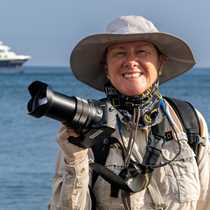Isabela and Fernandina Islands
The sea turned from small choppy waves to smooth in an instant. The up-welling cooler waters had calmed the sea surface to make our sailing over the Equator line a breeze. Ecuador Volcano was stark in her appearance on our western side as we cruised by, learning about the kayaks and preparing ourselves for a visit to Punta Vicente Roca, the “lower lip of the sea horse.” As Isabela Island resembles a sea horse, so we orient ourselves to our location. The Zodiacs were lowered and set off to explore the ocean realm, as were the kayaks a short time later. We went into a cave with marine turtles popping their heads out now and again. Pacific burrfish could be seen below the surface and later seen through masks with snorkels. The snorkelers had a fantastic time, as the East Pacific green marine turtles were seen by the dozen immediately upon entering into the chillier but by no means uncomfortable waters of the west. One cruised by with its own style of tattoo, a brilliantly red sea star attached to its hind left flipper. It would be hard to imagine a better situation; the turtles grazed on algae just inches below us, oblivious of our presence; a sensation foreign to most of us.
The afternoon took us onto the island of Fernandina where the large marine iguanas were both entering and leaving the low tide waters, grazing on fields of green algae. The flightless cormorants were caring for young in the nest while a Galápagos hawk stood on a rock nearby, apparently with a damaged wing. We have no idea how it occurred, but natural selection works every day, every minute, in ways we have yet to understand.
We are traveling in a world today that is still relatively untouched by humans. Fernandina lives as she has for thousands of years. We are privileged to have seen this for a few short hours; a reminder that humans, here at least, are not yet the center of the universe.
The sea turned from small choppy waves to smooth in an instant. The up-welling cooler waters had calmed the sea surface to make our sailing over the Equator line a breeze. Ecuador Volcano was stark in her appearance on our western side as we cruised by, learning about the kayaks and preparing ourselves for a visit to Punta Vicente Roca, the “lower lip of the sea horse.” As Isabela Island resembles a sea horse, so we orient ourselves to our location. The Zodiacs were lowered and set off to explore the ocean realm, as were the kayaks a short time later. We went into a cave with marine turtles popping their heads out now and again. Pacific burrfish could be seen below the surface and later seen through masks with snorkels. The snorkelers had a fantastic time, as the East Pacific green marine turtles were seen by the dozen immediately upon entering into the chillier but by no means uncomfortable waters of the west. One cruised by with its own style of tattoo, a brilliantly red sea star attached to its hind left flipper. It would be hard to imagine a better situation; the turtles grazed on algae just inches below us, oblivious of our presence; a sensation foreign to most of us.
The afternoon took us onto the island of Fernandina where the large marine iguanas were both entering and leaving the low tide waters, grazing on fields of green algae. The flightless cormorants were caring for young in the nest while a Galápagos hawk stood on a rock nearby, apparently with a damaged wing. We have no idea how it occurred, but natural selection works every day, every minute, in ways we have yet to understand.
We are traveling in a world today that is still relatively untouched by humans. Fernandina lives as she has for thousands of years. We are privileged to have seen this for a few short hours; a reminder that humans, here at least, are not yet the center of the universe.




